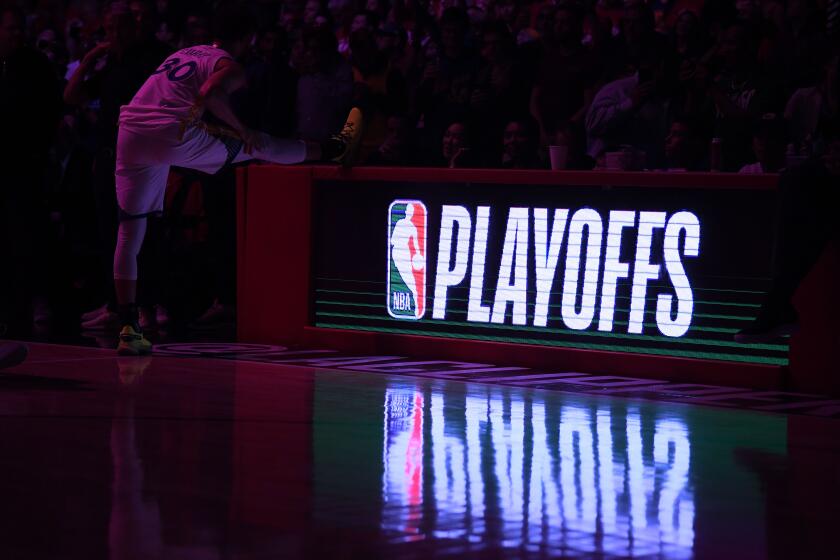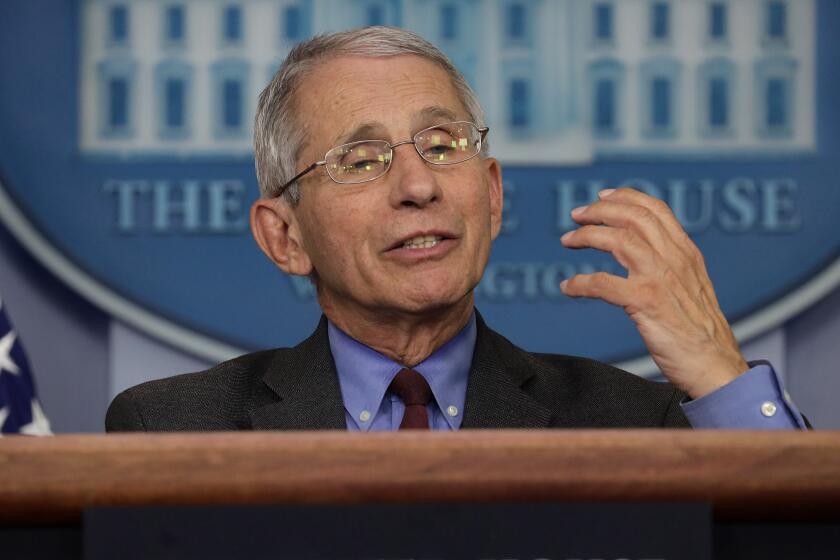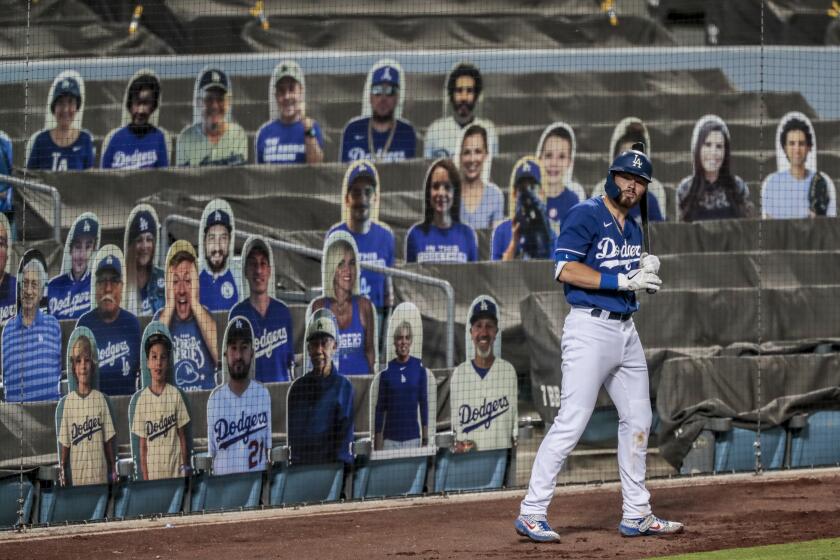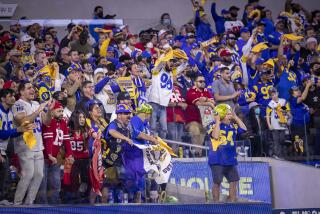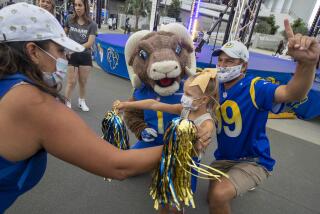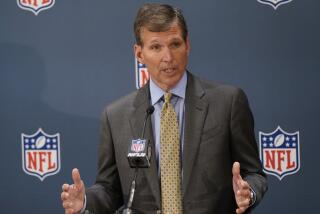Drive-in games? Sparse crowds? They could be part of sportsâ new normal

When pro soccer returns to Denmark, ending its COVID-19 hiatus as early as next month, games will be played in empty stadiums, but the FC Midtjylland team has devised a way to get fans involved.
The club will erect massive video boards outside its MCH Arena, facing a parking lot where more than 2,000 designated spots will serve as a sporting version of the old-fashioned drive-in movie.
Fans will watch the game together â or, at least, in close proximity â chanting and singing from their cars. Images of this unorthodox crowd will be shown inside the venue so players wonât feel so alone.
If that sounds odd, the U.S. should take note. When American sports return, and spectators are eventually allowed back in, there could be big changes.
âPeople enjoy being in a stadium, I get that,â said Karin Michels, chair of epidemiology at UCLAâs Fielding School of Public Health. âItâs possible, but the experience will be different.â
The new normal at ballparks could involve more than cheering through face masks. It could mean having your temperature checked as you enter and sitting with empty seats on either side. That hot dog from the concession stand? It might come hermetically sealed.
A look at what trainers and medical experts think about NBA players returning to games.
The further we remain from a reliable treatment or vaccine for COVID-19, the more extreme things could get, experts say. Imagine teams of ushers wearing masks and gloves, constantly wiping down railings. Or security guards threatening to eject anyone who violates social-distancing rules.
âWhat happens when someone coughs?â asked Gil Fried, chair of sports management at the University of New Haven in Connecticut. âThere are not going to be any clear solutions.â
::
Professional baseball has returned to Taiwan, with a handful of teams playing before empty stands. South Koreans recently held their first spring training games.
Sports leagues throughout North America and Europe are hoping to resume by summer, though it could be months longer before fans are allowed to attend. When asked what that experience might look like, public health experts envision a set of basic precautions.
The need for social distancing will preclude any sort of tailgating in the parking lot, they say. With seats at most stadiums less than two feet wide, it will take empty spots â lots of them â to give each fan or group of ticket holders adequate clearance in all directions.
Capacity might be limited to half or one-third of normal, experts estimate.
âA building is going to deliver what itâs asked to deliver,â said an official at a major U.S. arena who was not authorized to speak publicly. âUntil we know what the health department is going to mandate, itâs hard to predict.â
Dr. Anthony Fauci says potential plans to play MLB games in locations away from fans is âbetter than nothingâ during the coronavirus outbreak.
Sports might also take a cue from policies that essential businesses have adopted over the last month or so, with hand sanitizers readily available and customers required to wear face coverings.
âMy wife just bought masks that have the Golden State Warriors logo on them,â said Dan Rascher, a sports management professor at the University of San Francisco. âTeams could hand those out at the door.â
There are other lessons to be learned.
Like some grocery stores, where workers wipe down carts as customers enter, arenas could employ large staffs to clean railings, counters and other touch points. Those strips of colored tape on the floor at the checkout stand could be used for restrooms and condiment stations, keeping lines adequately spaced.
And contact-free food delivery offered by restaurants might translate to concessions.
âThere could be apps for fans to order on their phones,â Rascher said. âThey could bring the food to your seats.â
But making arenas safer represents only part of the challenge. They will also have to look safer to consumers timid about venturing into a public space.
âThe average fan of Major League Baseball is in their late 50s,â said Fried, who has written extensively about risk management at sports venues.
That number, which appears in a 2017 study of Nielsen viewership data commissioned by Sports Business Journal, verges on one of the CDCâs highest-risk groups for coronavirus.
Addressing âthe psychological side, the phobias we haveâ will be key for venue operators, Fried said. And that could prove difficult.
::
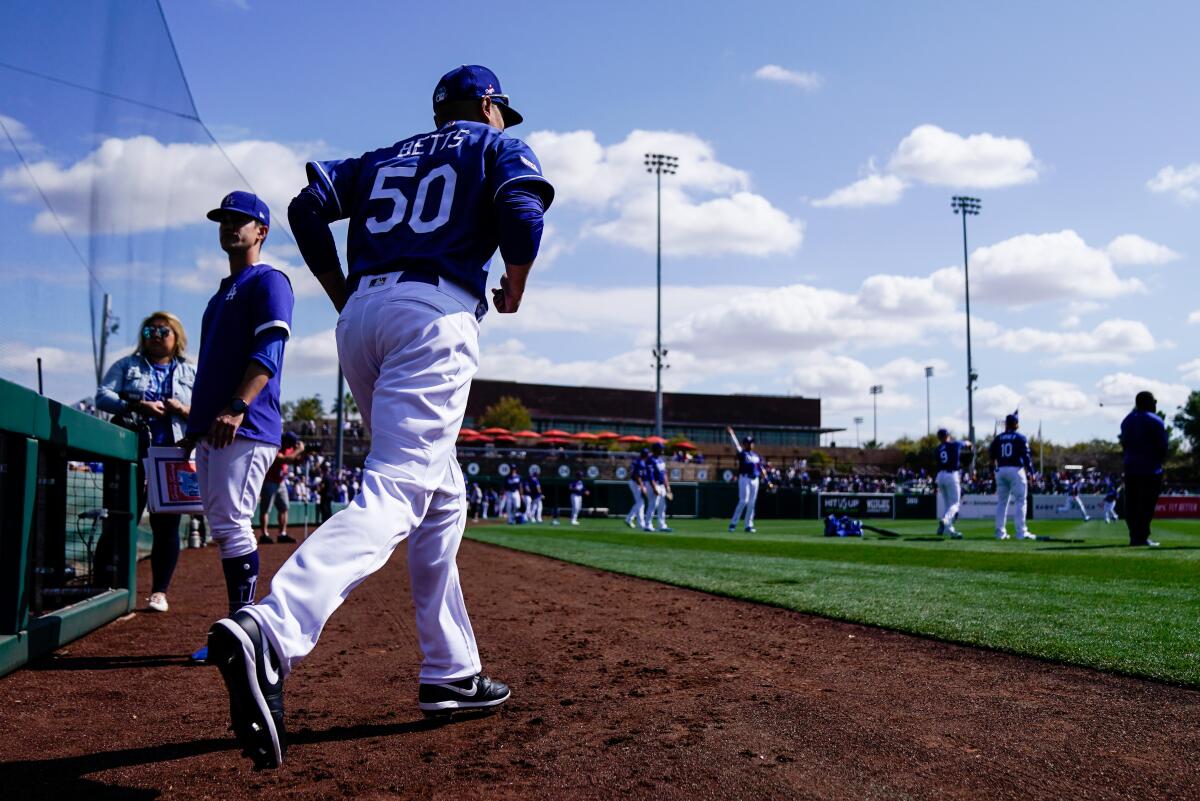
The coronavirus pandemic has been so difficult to contain, in part, because the virus can be spread by people exhibiting no symptoms. So temperature checks wonât be foolproof.
âSomeone could be in the stadium not knowing they are infected,â Michels said. âYou donât want to be near them.â
Still, scanning each forehead that passes through the entrance could serve as a visual reassurance. Same goes for ushers in quasi-hospital garb, those carefully sealed hot dogs and plenty of elbow room in the stands.
Individual behavior is another matter.
When some beaches in Florida reopened last week, news coverage showed crowds forming along the waterâs edge, clusters of people disregarding official pleas for social distancing. What happens if spectators disregard basic health guidelines at arenas, purposely or by accident?
âPeople may get really engaged in the game,â Michels said. âThey may forget.â
That means no high-fives or chest bumps, not even when your team scores in the final seconds. Showing reminders every 15 minutes on the videoboard might not suffice; venues might have to police in a whole new way.
Can security guards remove ticket holders who insist on standing too close in the restroom line? What happens if customers complain that someone in Section D is coughing incessantly?
âAre we automatically going to jump on them and say they have the virus?â Fried says.
Stories examining the impact the spread of the coronavirus has had on the NBA, NHL, MLB, the NCAA tournament and the rest of the sports world.
Experts worry about another potential complication: Beer.
Sports and drinking â occasionally to excess â have always gone hand-in-hand. In 2011, researchers took breath samples from 362 people as they left 16 pro football and baseball games, finding that 40% had measurable blood-alcohol concentration levels and 8% registered above the legal limit.
For some, the reopening of stadiums could serve as a test of personal discipline.
âOn the whole, people are responsible,â Michels said. âBut fans must understand that if they donât play by the rules, it will be back to watching on television.â
::
Spectators arenât the only ones frightened by COVID-19. As a recognized scholar in his field, Fried has dealt with venue owners and sports organizations across the country.
âIâve done emergency action plans for a number of stadiums,â he said. âWeâve looked at earthquakes, hurricanes, tornadoes, weapons of mass destruction ⌠never anything like this.â
The prospect of welcoming thousands of customers into their buildings during a pandemic has venues worried that âpeople are going to be second-guessing every decision they make,â Fried said.
The last global virus of this scale dates to the 1918 Spanish flu, so there arenât many established guidelines to follow. Sports management and public health experts pin their hopes on fresh ideas, invention driven by the necessity facing an industry that desperately wants to generate revenue again.
While Ducks hockey is on hiatus because of the coronavirus outbreak, the Honda Center parking lot is being used as site for weddings and food distribution.
âItâs imperative for the teams to be innovative and come up with solutions that will bring people back,â Rascher said. âSometimes sports havenât caught up with other industries, but they do understand their fans.â
Safety â and the appearance of safety â will be critical. So will finding ways to enhance the game-day experience under odd and trying circumstances.
Two years ago, when the forecast called for gusty winds and subzero temperatures during the opening ceremony of the 2018 Winter Olympics in South Korea, organizers had to adjust.
They handed everyone arriving at the Olympic Stadium what amounted to a survival kit, including blankets and foot warmers. All those people bundled up in scarves and thick gloves also received noisemakers to compensate for otherwise muffled cheers and clapping.
More recently, with baseball back on the field in Taiwan, the Rakuten Monkeys filled the stands with cardboard cutouts of spectators and animatronic, wig-wearing drummers. The Chinatrust Brothers pumped chants into their empty ballpark.
If the NBA, NHL and Major League Baseball resume play in coming months â and fans show up with their mouths and hands covered for health reasons â might American teams try a similar gambit?
The new normal, Fried suggests, could extend beyond rules and regulations.
âLook at TV shows that have laugh tracks,â he said. âMaybe theyâll do the same thing at games.â
More to Read
Go beyond the scoreboard
Get the latest on L.A.'s teams in the daily Sports Report newsletter.
You may occasionally receive promotional content from the Los Angeles Times.

